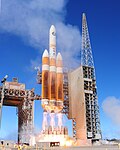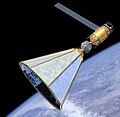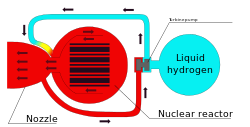The highest specific impulse chemical rockets use liquid propellants (liquid-propellant rockets). They can consist of a single chemical (a monopropellant)...
50 KB (3,666 words) - 06:14, 17 April 2025
A liquid-propellant rocket or liquid rocket uses a rocket engine burning liquid propellants. (Alternate approaches use gaseous or solid propellants.)...
53 KB (6,608 words) - 04:23, 20 May 2025
Wiktionary, the free dictionary. A hypergolic propellant is a rocket propellant combination used in a rocket engine, whose components spontaneously ignite...
25 KB (2,685 words) - 02:13, 7 May 2025
Rocket propellant is used as reaction mass ejected from a rocket engine to produce thrust. The energy required can either come from the propellants themselves...
29 KB (3,932 words) - 02:16, 7 May 2025
hybrid-propellant rocket is a rocket with a rocket motor that uses rocket propellants in two different phases: one solid and the other either gas or liquid....
56 KB (6,958 words) - 22:05, 31 March 2025
solid-propellant rockets or motors) are chemical rockets which use propellant in a solid state. Liquid-propellant rockets use one or more propellants in a liquid state...
101 KB (11,722 words) - 04:15, 17 May 2025
monopropellant rocket (or "monochemical rocket") is a rocket that uses a single chemical as its propellant.[contradictory] Monopropellant rockets are commonly...
16 KB (1,747 words) - 03:51, 28 April 2025
storage, most propellants are stored as either a solid or a liquid. A rocket propellant is a mass that is expelled from a vehicle, such as a rocket, in such...
29 KB (3,836 words) - 13:39, 12 May 2025
A solid-propellant rocket or solid rocket is a rocket with a rocket engine that uses solid propellants (fuel/oxidizer). The earliest rockets were solid-fuel...
44 KB (5,414 words) - 22:21, 28 April 2025
tripropellant rocket is a rocket that uses three propellants, as opposed to the more common bipropellant rocket or monopropellant rocket designs, which...
8 KB (1,055 words) - 10:25, 29 April 2025
surrounding air. A rocket engine produces thrust by reaction to exhaust expelled at high speed. Rocket engines work entirely from propellant carried within...
107 KB (11,404 words) - 02:45, 13 May 2025
RP-1 (redirect from Rocket propellant-1)
(Rocket Propellant-1 or Refined Petroleum-1) and similar fuels like RG-1 and T-1 are highly refined kerosene formulations used as rocket fuel. Liquid-fueled...
22 KB (2,711 words) - 18:05, 4 May 2025
Since one or more of the propellants is in the liquid phase, all cryogenic rocket engines are by definition liquid-propellant rocket engines. Various cryogenic...
12 KB (645 words) - 23:30, 2 May 2025
mounted on an adapted 88 mm gun mounting. The rocket was driven by a liquid fueled engine. The liquid propellant used was a hypergolic mixture consisting of...
7 KB (699 words) - 20:40, 18 April 2025
liquid rocket propellants including RP-1 (kerosene), hydrazine and nitrogen tetroxide (NTO), and mildly cryogenic, space-storable propellants like liquid methane...
73 KB (7,970 words) - 22:16, 1 April 2025
Rutherford is a liquid-propellant rocket engine designed by aerospace company Rocket Lab and manufactured in Long Beach, California. The engine is used...
13 KB (918 words) - 21:04, 14 July 2024
Curie is a liquid-propellant rocket engine designed and manufactured by Rocket Lab. A bipropellant is used for the propulsion of the third stage/kick...
7 KB (573 words) - 10:56, 21 February 2025
weighed approximately 500,000 kilograms. Compared to liquid propellant rockets, the solid-propellant motors (SRMs) have been capable of providing large...
9 KB (857 words) - 12:45, 9 February 2025
Archimedes is a liquid-fuel rocket engine burning liquid oxygen and liquid methane in an oxidizer-rich staged combustion cycle. It is designed by aerospace...
9 KB (682 words) - 11:08, 5 November 2024
1970, Clark developed liquid propellants at the Naval Air Rocket Test Station at Dover, New Jersey (known as the Liquid Rocket Propulsion Laboratory of...
13 KB (1,606 words) - 12:26, 29 May 2024
become the seventh country in the world to have a medium-sized liquid-propellant rocket engine over 75 tons. Nuri (KSLV-II) is a three-stage launch vehicle...
28 KB (2,173 words) - 20:13, 19 May 2025
bases. Liquid oxygen is the most common cryogenic liquid oxidizer propellant for spacecraft rocket applications, usually in combination with liquid hydrogen...
13 KB (1,289 words) - 18:19, 26 April 2025
rocket (NTR) is a type of thermal rocket where the heat from a nuclear reaction replaces the chemical energy of the propellants in a chemical rocket....
58 KB (7,136 words) - 04:16, 9 March 2025
Subcooling (redirect from Subcooled propellant)
in refrigeration cycles and steam turbine cycles. Some rocket engines use subcooled propellants. In refrigeration systems, subcooling the refrigerant is...
14 KB (1,598 words) - 14:31, 29 January 2025
multistage rocket or step rocket is a launch vehicle that uses two or more rocket stages, each of which contains its own engines and propellant. A tandem...
41 KB (5,493 words) - 17:29, 15 April 2025
propulsion do. The rocket would only have to carry the means of capturing solar energy, such as concentrators and mirrors. The heated propellant would be fed...
13 KB (1,547 words) - 10:38, 29 March 2025
History of Liquid Propellant Rocket Engines. AIAA. p. 799. ISBN 9781563476495. Sutton, George Paul (2006). History of Liquid Propellant Rocket Engines....
9 KB (600 words) - 12:13, 30 March 2025
of ULA's new Vulcan rocket. Centaur was the first rocket stage to use liquid hydrogen (LH2) and liquid oxygen (LOX) propellants, a high-energy combination...
47 KB (4,402 words) - 07:29, 5 April 2025
Cryogenic fuel (redirect from Cryogenic propellant)
temperatures in order to maintain them in a liquid state. These fuels are used in machinery that operates in space (e.g. rockets and satellites) where ordinary fuel...
11 KB (1,227 words) - 12:57, 17 June 2023
perchlorate composite propellant (APCP) is a solid rocket propellant. It differs from many traditional solid rocket propellants such as black powder or...
15 KB (2,022 words) - 04:27, 8 May 2025


















